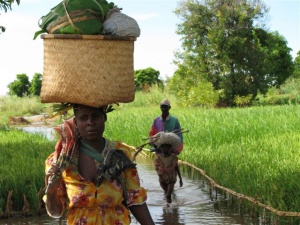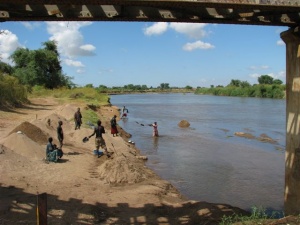Gender and Climate Change


Woman carrying goods through the flood waters in Malawi (photo: Gina Ziervogel)
Recent work done by SEI Oxford on climate adaptation and DRR in southern Africa touched on gender issues, which was of particular interest to Oxfam, who commissioned the study. Here are some extracts from the report:
Recognising differential vulnerability is important when developing adaptation strategies. Investigating the differences between the vulnerability of men and women is an area that requires specific attention. This is particularly important in many southern African communities where women and men often undertake different reproductive activities. Women can be vulnerable to low rainfall and drought because during these times they often have to fetch water and firewood from further away.
In times of low crop yields and food insecurity, many people seek casual work and use the earnings to buy food and meet basic household needs. In the rural areas people might mould bricks or work on someone’s plot and in town they might work in construction. Both men and women engage in these activities although certain activities may be gendered. For example men might search for wood to make charcoal. They may then have to travel far distances into town to sell it causing a shortage of labour in the fields resulting in women doing more of the work. There are also differential impacts depending on whether there are 2 adults or only a single adult in the household. If there are 2 adults that both find work then the household will collectively earn more money. However, some people in Malawi noted that in some cases it may be easier for the woman in a female headed household to go out and try to find work because she can just go, whereas a woman with a husband first has to look after the man and often ask his permission before she can go out and look for work.

Men digging in the river, Malawi (photo: Gina Ziervogel)
There are also links between climate and agriculture, gender and health. When yields are low and there is income insecurity, crime and prostitution often increases. It was noted that some men run away from their responsibilities at this time and only come back when there is food in the house. Some women resort to prostitution to get food for the children and this leads to an increase in the spread of HIV. Some women are only likely to engage in sex for food transactions when the man is away. In one area close to Lilongwe with a high number of bars, a group of women suggested that in their area between 5 to 7 out of 10 households have woman that might resort to sex for food transactions in the critical months from December to January.
Despite the differences in vulnerability it is important to explicitly engage women in developing adaptation strategies as they have an important role to play in understanding the social dynamics. Particularly during disaster response they play an important role in the recovery process. For this reason, it is critical to incorporate gender specific activities at the community and provincial level.
Differential and dynamic vulnerabilities need to be assessed in order to prioritise and target adaptation responses. An assessment of vulnerability to climate change should be contextualised within other development challenges that are faced at the local level. It is critical that vulnerability to climate change is assessed at a scale that is relevant to the programme or project, rather than assuming everyone is equally vulnerable i.e. national vulnerability assessments may help to identify key areas to target, but effective responses will need to be based on a more nuanced understanding of intra-community and even intra-household vulnerabilities. This will help to prioritise where adaptation responses need to focus initially and also inform the nature of these responses, for example if they need to be gender, age or culture specific. In some areas it might be clear that the rains that used to start in a certain month now tend to start later. For example, in southern Zambia there appears to have been a delay in the onset of the rainfall season and lengthening of the dry spell. In these areas, households reliant on rain-fed agriculture might already be vulnerable. In other areas it might be women or children who are significantly vulnerable, because of social norms, and need to be supported in developing adaptation responses. Key to this is understanding the interaction between a number of biophysical, economic and socio-cultural stressors that people face. Interventions need to consider these interactions as well as differences in response priorities of stakeholders.
Better vulnerability indicators could contribute to monitoring differential vulnerabilities and how these change over time, but they have to be iteratively revised to make sure that the indicators can capture possible new emerging vulnerabilities. In Mozambique for example, loss of life in the 2000 and 2008 floods served as benchmarks but it would be useful to have more nuanced indicators that enable post-disaster event responses to strengthen livelihoods where needed and address issues of social protection, risk management, economic losses, and risk transfer.
For a more general overview of this work and to access the whole report click through to Climate adaptation in southern Africa: Addressing the needs of vulnerable communities
Additional resources
Gender aspects of climate change, IUCN et al report [1]
Climate Change and Disaster Mitigation: Gender makes the difference, IUCN briefing note by Aguilar, L. [2]
Resource Guide on Gender and Climate Change, UNDP publication 2009 [3]
Changing the Climate: Why Women’s Perspectives Matter, a report by the Women’s Environment and Development (WEDO) 2007 [4]
A study of gender equality as a prerequisite for sustainable development (specifically relating to climate change), Report to the Environment Advisory Council, Sweden, by Johnsson-Latham, G. 2007 [5]
Gender and Climate Change: mapping the linkages BRIDGE (IDS) 2008, prepared for the UK Department for International Development. [6]
There are a number of useful documents and resources available on the GenderCC platform and in the Eldis – Gender guide/dossier.
Related Paper
Escobar et al. (2008) Women’s role in adapting to climate change and variability
Abstract: Given that women are engaged in more climate related change activities than what is recognized and valued in the community, this article highlights their important role in the adaptation and search for safer communities, which leads them to understand better the causes and consequences of changes in climatic conditions. It is concluded that women have important knowledge and skills for orienting the adaptation processes, a product of their roles in society (productive, reproductive and community); and the importance of gender equity in these processes is recognized. The relationship among climate change, climate variability and the accomplishment of the Millennium Development Goals is considered.
(0) Comments
There is no content